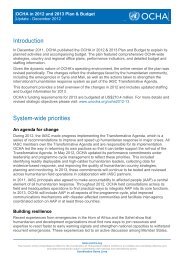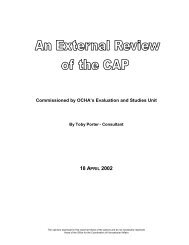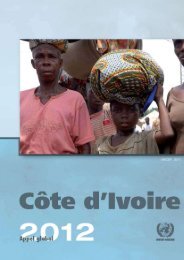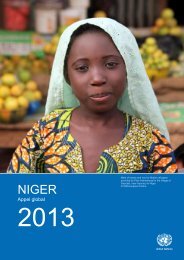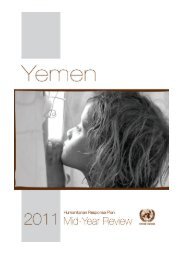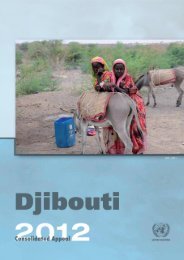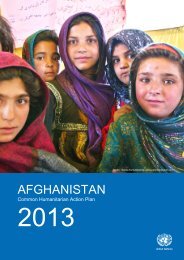Table of contents
Untitled
Untitled
You also want an ePaper? Increase the reach of your titles
YUMPU automatically turns print PDFs into web optimized ePapers that Google loves.
50[2] NEEDS PROGRESS Analysis | sector response United Nations and PartnersSUDAN MID YEAR WORK REVIEW PLAN | Sudan 2012 work plan 2012expressed reluctance to accommodate asylum seekers in theeast as they are seen as economic migrants.The increasing difficulty <strong>of</strong> obtaining travel permits for beneficiariesbetween eastern Sudan and Khartoum has contributedto a rise in trafficking. Since refugees and asylum seekers wereunable to obtain travel permits, they had to resort to smugglersto move away from the east which in turn exposed themto more risk <strong>of</strong> being trafficked by those very smugglers.Achievements as <strong>of</strong> 15 May 2012Regarding basic assistance, 8,000 refugees in Darfur receivedbasic services in line with UNHCR standards and indicators.In the East, approximately 4000 new arrivals received monthlyfood assistance.In the area <strong>of</strong> education, a parent-teacher association (PTA)was set up in Um Shalaya camp in Darfur. A total <strong>of</strong> 140 menand women were enrolled in literacy classes, while 96% <strong>of</strong> thechildren are attending primary education.In Khartoum, asylum-seekers and refugees continued to beprovided with protection counseling by UNHCR, with 750 individualsbenefiting from this service during the reporting period.Legal advice and representation was also provided by lawyersin the East and Khartoum. Detention monitoring activities inKhartoum resulted in the release <strong>of</strong> 249 individuals concernedto UNHCR out <strong>of</strong> 387 individuals monitored. Although deportations<strong>of</strong> asylum-seekers from Eastern Sudan continued (24to date), no reports <strong>of</strong> refoulement were received from Khartoum.This is an improvement on 2011.Implementation challengesChallenges faced by the sector include an increasingly difficultenvironment for refugees and asylum-seekers due to restrictionson freedom <strong>of</strong> movement, the deteriorating economicsituation in the country and limitations on services benefitingrefugees and asylum-seekers.continue but it is foreseen that the needs will exceed the fundingcurrently available.In West Darfur, Medair, which was providing key servicesincluding health and water, phased out its activities completelyand most <strong>of</strong> these were immediately taken over by the INGOMerlin. UNHCR has taken measures to cover the gaps left inUm Shalaya refugee camp for water, sanitation and healthservices. Part <strong>of</strong> the services will be provided by Save theChildren. Funding for this remains insufficient. There havebeen some challenges concerning the increasing number <strong>of</strong>patients using the refugee clinic in Um Shalaya who come fromthe IDP returnee and host communities as well as nomads.Changes in TargetsNo changes in targets.Sector Project RevalidationProjects were validated during the Technical Review discussionsthat were held with the different sector members duringthe HWP preparation phase in January 2012.Coverage <strong>of</strong> Needs by Actors not in the Sectoror CAPNone reported.Refugees in Sudan by country <strong>of</strong> originCountry <strong>of</strong> origin Refugees %1 Eritrea 103,193 742 Chad 31,871 233 Ethiopia 4,430 3.14 DRC 5 0.15 Others 492 1.0Total 139,991 100Source: UNHCR (2012)[2][3] [5] [4]139,991refugees[1]Some arrests and deportations <strong>of</strong> refugees and asylum-seekerscontinue for unlawful movement. Kassala state authoritieshave expressed reluctance to accommodate asylum-seekersmoved from other states or border areas as they are seen asillegal migrants due to their planned onward movement. Theincreasing difficulty <strong>of</strong> obtaining travel permits for beneficiariesbetween the East and Khartoum has contributed to a risein trafficking, since refugees and asylum-seekers cannot movelegally according to the provisions <strong>of</strong> the Sudanese AsylumAct. Reports continued <strong>of</strong> kidnappings in border areas as wellas from the camps. Some round-ups and arrests <strong>of</strong> asylumseekersand refugees also continued in Khartoum in spite <strong>of</strong>joint efforts by COR and UNHCR to reduce them. Some NGOswere asked to close their projects in the East following anassessment by HAC, which resulted in difficulties in providingsome services to refugees.The number <strong>of</strong> students in refugee community schools in Khartoumcontinued to rise, which will require the construction <strong>of</strong>additional classrooms. Enrolled students include children fromthe local community. The issue <strong>of</strong> obtaining licenses for refugeecommunity schools remains unresolved. Medical referrals




